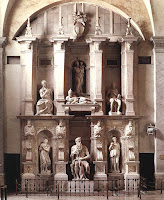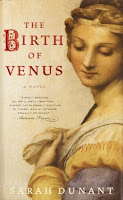Summary: A biographical novel based on the life of the great artist Michelangelo. It is based in the Renaissance times —the powerful Medici family, the monk Savonarola, and the political turmoil which in intrinsically linked with his art making. The novel begins in his childhood when he begins his first apprenticeship and ends with his death when he is almost ninety, spanning the years where he is possessed with the fury of making magnificent art.
Review: This epic novel was brilliant and inspiring. It brought to life the turbulent Renaissance times and the genius of Michelangelo. His need to create art pervaded the book. The longing which he felt to carve stone, superseded any other emotional attachment in his life. My favorite parts were the descriptions of his state of mind as he conceptualized new sculptures or paintings. He put so much thought even into the traditional and mythical figures like Mary, David, Hercules and Christ, figuring out which stage of life he wanted to reveal them in, what they were to signify and how to best achieve that.
His obsession with his art, was juxtaposed by the difficult scenarios he found himself in, where he was forced to stay away from that what he loved. Even as fame came to him, the Popes wanted him to create works to immortalize them, in the process drawing him away from that which drove him. He became a pawn in the political struggles that scarred the landscape of Italy. But even as he created works that he was compelled to do, he was unable to to do them in a mediocre way. He had to do them to the best of his ability, disregarding money, food and even sleep. I was fascinated to learn that the Sistine Chapel ceiling which he is famous for, was also a commission which dismayed him, as it kept him away from marble carving. His greatest love was for marble carving and the language of the book, in the description of the process of selecting, carving and even describing the marble, portays this beautifully.
It was interesting to see his relationship with other artists, especially Leaonardo Da Vinci and Raphael, two other famous artists of this period. In terms of the women in his life, only his relationship with his first love, Contessina, Lorenzo de Medici's daughter, stayed with me. His relationship with his family was difficult to read about. His father's lack of interest in his art and only in the money it brought is not surprising but frustrating.
Even though it was absorbing, the book was a slow read. I felt that his sense of purposelessness when he was not involved in creating art, coincided with the slowing down of the narrative. And when he was engrossed in making new works, the pages rushed by. This was my personal experience, probably because I really enjoyed reading about his art-making. It was heart-breaking when the arm of his David broke due to a mob of fighting people. It makes one realize how ephemeral art can be. It took him years and years to create some of these works and they could be destroyed so easily. His bronze statue of one Pope was melted and made into a cannon, with the change in power structure. I actually felt anxious when there were discussions of painting over his Sistine Chapel painting as people thought it "ungodly."
Besides the actual process of art making, there was this fury to create art that pervaded the entire text, which I found captivating. He was so in love with his work that he dismissed any practical and logical thoughts, doing whatever he could to get his hands on marble. He was driven by bringing his own unique interpretation to his art, in a time where staying true to convention was revered in artists. He actually performed dissections, something he could have been hanged for, because he felt he must understand the inner workings of the body in order to display them in art. He defied a Pope, questioned all authority and challenged the best artists of his time. At the same time, he doesn't come across as a vain person, just someone who was solely consumed by his passion for his art.
I think everyone should read this book to understand the trials and tribulations one of the greatest artist ever, faced in his lifetime. The book is perfectly titled "The Agony and the Ecstacy" because it is marked by these extreme emotions. It is a fascinating read about the Renaissance times, the power struggles, the questions of faith and most of all the genius of Michelangelo.
Review: This epic novel was brilliant and inspiring. It brought to life the turbulent Renaissance times and the genius of Michelangelo. His need to create art pervaded the book. The longing which he felt to carve stone, superseded any other emotional attachment in his life. My favorite parts were the descriptions of his state of mind as he conceptualized new sculptures or paintings. He put so much thought even into the traditional and mythical figures like Mary, David, Hercules and Christ, figuring out which stage of life he wanted to reveal them in, what they were to signify and how to best achieve that.
 |
| David |
It was interesting to see his relationship with other artists, especially Leaonardo Da Vinci and Raphael, two other famous artists of this period. In terms of the women in his life, only his relationship with his first love, Contessina, Lorenzo de Medici's daughter, stayed with me. His relationship with his family was difficult to read about. His father's lack of interest in his art and only in the money it brought is not surprising but frustrating.
 | |
| Sistine Chapel |
 | |
| Tomb of Julius II |
 | |
| Pieta |

